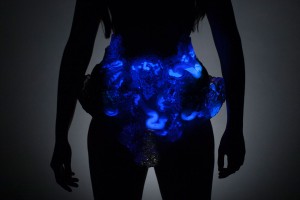Designing Wearables for Interplanetary Pilgrims
-
-
slice.mit.edu
Filed Under

Recommended
Caption: AL-QAMAR: Luna's Wanderer contains pods for algae-based air-purification and biofuel collection to produce and store oxygen. Photo: Yoram Reshef.
Sturdy, wearable skins that transform hostile environments into friendlier ones are among the projects developed by Media Lab’s Mediated Matter group, headed by Associate Professor Neri Oxman PhD ’10.
Oxman, who earned her PhD in design computation, leads her Mediated Matter group through explorations of “Nature-inspired Design and Design-inspired Nature” using the tools of computational design, digital fabrication, materials science, and synthetic biology. Many projects rely on advanced 3D printing technologies.
Four artifacts that represent this intersection of 3D printing and synthetic biology were unveiled in Germany last fall in an exhibit of Wanderers: An Astrobiological Exploration, a collaboration with German designers Christoph Bader and Dominik Kolb.
 Mushtari
Mushtari
The wearables, printed with Stratasys multi-material 3D printing technology, are designed to create the necessities of human life in space environments. Capillaries are expected to hold synthetically engineered microorganisms that could produce oxygen, light, food, and biofuels. Mediated Matter members led by Will Patrick and Sunanda Sharma are working on embedding living matter in the form of engineered bacteria inside the 3D structures.
"The future of wearables lies in designing augmented extensions to our own bodies, that will blur the boundary between the environment and ourselves," according to Oxman. "With this collection, we have designed spatially and materially complex wearables pointing towards the possibility of containing living matter that can interact with the environment.”
Learn about Oxman's earlier work in a previous Slice post, "FAB:REcology–Building on Natural Principles," and current projects on her Media Lab page.







